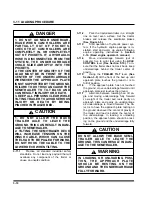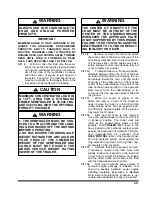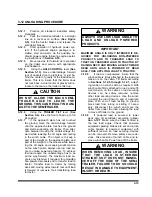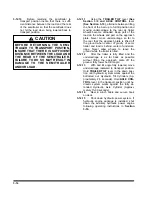
3-12 UNLOADING PROCEDURE
3-12.1
Practice all standard industrial safety
standards.
3-12.2
Park the tractor/semitrailer in a straight
line on a level even surface
(See Figure
Set the tractor brakes and release the
semitrailer brakes.
3-12.3
Start operation of hydraulic power sys-
tem. If the hydraulic engine package is in-
stalled, start and warm up the auxiliary hy-
draulic power engine following engine operat-
ing instructions in
Section 3-16.
3-12.4
Move load as far forward as is practical
on the trailer and secure with appropriate
load tiedowns.
3-12.5
Using the
AXLE CONTROL
lever
(See
Section 3-10)
, move undercarriage forward
(out of pockets) five to eight feet, or just be-
hind the center of gravity of the loaded semi-
trailer. This is to insure that the trailer does
not rock back. Actual center of gravity will re-
locate to the rear as the trailer is tilted up.
CAUTION
DO NOT ALLOW THE BACK SEMI-
TRAILER AXLE TO LEAVE THE
GROUND. THIS CAN RESULT IN DAM-
AGE TO THE SEMITRAILER.
3-12.6
Using the
TRAILER TILT
lever
(See
Section 3-9),
raise the front of bed up to full
tilt position.
3-12.7
If the approach plate has not touched
the ground, move the undercarriage forward
until the approach plate touches the ground
and starts supporting the trailer. Then alter-
nate between moving the undercarriage for-
ward while lowering the tilt angle and reeling
in the winch cable. The object is to keep a
part of the weight on the approach plate, and
part of the weight on the wheels while lower-
ing the tilt angle and keeping slight tension
on the winch cable. Always use low load an-
gle to unload powered products. To achieve
low load angle, the undercarriage has to be
all the way forward. The maximum load an-
gle is only intended, if required, for unloading
non-powered products and to transfer load to
tractor. Transfer load to tractor by raising
deck and moving axles toward rear until load
is forward of rear axle, thus transferring load
to tractor.
WARNING
ALWAYS USE LOW LOAD ANGLE TO
LOAD AND UNLOAD POWERED
PRODUCTS.
IMPORTANT
MAXIMUM ANGLE IS ONLY INTENDED IF RE-
QUIRED FOR UNLOADING NON-POWERED
PRODUCTS AND TO TRANSFER LOAD TO
TRACTOR. TRANSFER LOAD TO TRACTOR BY
RAISING DECK AND MOVING AXLES TOWARD
REAR UNTIL LOAD IS FORWARD OF REAR
AXLE, THUS APPLYING LOAD TO TRACTOR.
3-12.8
If load is non-powered, insure that the
winch cable is firmly attached to the load and
tension is on the cable. Tilt trailer according
to
Sections 3-12.5 through 3-12.7
, adjust-
ing tension on winch cable as required. With
winch cable firmly attached to load and suffi-
cient tension on the cable so load securing
devices can be safely removed, remove
other load securing devices. Use the winch
to assist the load down to end of approach
plate. With end of load resting on ground,
block load from rolling or sliding, if neces-
sary. Disconnect the winch and move the
trailer from under the load, allowing the load
to move off trailer to the ground.
3-12.9
If powered load is secured to lower
deck only, tilt semitrailer according to
Sec-
tion 3-12.7
. Make sure the trailer is tilted to
the low load angle. Check that powered
equipment parking brakes are set and winch
cable hooked to powered equipment with
sufficient tension so load securing devices
can be removed. Remove safety secure de-
vices. Take tension off winch cable and re-
move winch cable. Power load off the trailer.
WARNING
WHEN REMOVING LOAD, INSURE
THAT THE LOAD IS STEERING
STRAIGHT SO IT DOES NOT MANEU-
VER OFF THE SIDE OF THE SEMI-
TRAILER. FAILURE TO DO SO COULD
RESULT IN DAMAGE TO EQUIPMENT,
INJURY, OR DEATH.
3-13
Summary of Contents for 317C
Page 8: ......
Page 14: ...3 2 Figure 3 1 Front Trailer Terminology Figure 3 2 Rear Trailer Terminology...
Page 18: ......
Page 24: ...3 12 Figure 3 5 Steps for Loading and Unloading...
Page 30: ...3 18 Figure 3 10 Dock Leveler Operation...
Page 34: ...3 22 Figure 3 12 Front Extension Bulkhead...
Page 36: ...3 24 Figure 3 13 Rear Impact Guard and Antilock Brake System...
Page 40: ...4 2 Figure 4 1 Lubrication Points...
Page 45: ...4 7 Figure 4 2 317C 318C 319C Wiring Diagram...
Page 46: ...4 8 Figure 4 3 Remote Wiring Diagram...
Page 52: ...4 14 Figure 4 6 Checking Axle Alignment Figure 4 7 Examples of Camber...
Page 56: ...4 18 Figure 4 10 Axle and Brake Assembly...
Page 64: ...4 26 Figure 4 16 Mounting Tires and Wheels Figure 4 17 Stud Tightening Sequence...
Page 67: ...4 29 Figure 4 18 Dock Leveler Leg Assembly...
Page 68: ......
Page 78: ...5 10 NOTES...
















































